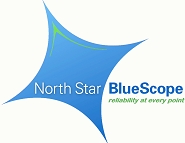Steel Mills

North Star BlueScope on Track for Expansion
Written by Sandy Williams
February 26, 2019
Australian steel producer BlueScope has upgraded the expansion plans for its U.S. segment, now planning to add 900,000 to 1.0 million tons of capacity at North Star BlueScope at an investment cost of $600-$700 million. The Ohio steel facility will receive a third electric arc furnace with a melt capacity of about 1.5 million tons as well as a second caster. BlueScope has committed $50 million to a design and engineering study with a final decision on the project expected during the second half of 2019. Construction will take two to three years to complete followed by a two-year ramp-up.
“What we are seeing at this stage is encouraging,” said CEO Mark Vassella during the company’s earnings conference call. The company is still working to secure some large capital items and environmental approvals, but unless there is some “fairly significant event,” the project is expected to move forward.
Asked to comment on all the steel capacity additions announced for North America, Vassella said not all plans are the same. North Star’s capacity expansion is justified on long-run average spreads and is going into a low cost advantaged asset, said Vassella. “I don’t see that in some of the other capacity, particularly in some of the blast furnace capacity that is coming back on. I’m not sure that capacity is going to survive a long-run spread cycle.”
“We think about [capacity additions] very carefully and we watch what our competitors are doing, but, equally, we think we have quite a privileged asset there and we want to keep investing in it and take advantage of its position,” he added.
When asked about raw material supply for the new EAF, given the reduction in ore supply following the mine disaster in Brazil, Vassella was confident that material will be available. He noted the strong supply of scrap in the Midwest that could be utilized, as well as pellets from the new HBI facility that Cleveland-Cliffs is constructing in Toledo.
At this point, BlueScope sees no need to lock in any contract volumes for the expanded mill. Vassella said he sees North Star as a “minnow” in an 80 million ton market.
“We know we have a good customer right next to us in Worthington that takes a chunk of our volume,” said Vassella. “And that’s a very tight and low cost supply chain that works well for both organizations.”
“Apart from Worthington, we tend to have low volumes and a low share of wallet, with a broad range of customers. And that is a nice mix for us,” he added.
North Star BlueScope saw sales in the first half of FY2019 (ending Dec. 31, 2018) jump 37 percent to $916.3 million year-over-year. Underlying EBITDA surged 138 percent to $320 million due to higher U.S. steel prices that exceeded increases in raw material costs.
Improved earnings were the result of continued robust demand in the U.S. and a strong focus on pricing and margin management, said BlueScope. Volumes, however, were down slightly during the last three months of 2018 as customers adjusted stock due to declining steel prices. Shipments for the period totaled 1.143 million tons.
BlueScope is expecting the average spread to be $40 per ton higher in the U.S. during the second half of FY2020.
Sales revenue for North Star’s parent BlueScope Steel jumped 17 percent year over year to AUD $6.4 billion (U.S. $4.6 billion). BlueScope reported a AUD $624.3 million net profit after tax (U.S. $488 million) for 1H FY2019 – a 42 percent improvement on 1H FY2018.
“It’s an excellent result, our best half on record. It was driven by strong demand and steel spreads in our U.S. and Australasian markets,” said Vassella.
(Note: tonnage in this article has been changed from metric to short tons.)

Sandy Williams
Read more from Sandy WilliamsLatest in Steel Mills

CRU: Tata Steel looks to shed 1,600 jobs in the Netherlands
The company said, “The challenging demand conditions in Europe driven by geopolitical developments, trade and supply chain disruptions and escalating energy costs have affected the operating costs and financial performance."

Reports: Federal funding for Cliffs’ project could be slashed
Elon Musk's DOGE is determining which Department of Energy grants to advance and which ones to terminate, according to several media outlets

Trump still against selling USS to Japanese firm: Report
Despite ordering a new review of Nippon Steel’s bid for U.S. Steel, President Trump said he is still against selling USS to a Japanese company, according to media reports.

Algoma looks to sell more steel in Canada in wake of Trump’s tariffs
The Canadian steelmaker said its absorbing higher tariffs as it moves forward.

Ancora abandons plan to take over leadership of USS
Investment firm Ancora Holdings Group has halted its play for U.S. Steel's board, citing Nippon Steel’s proposed bid for USS “gaining momentum.”
